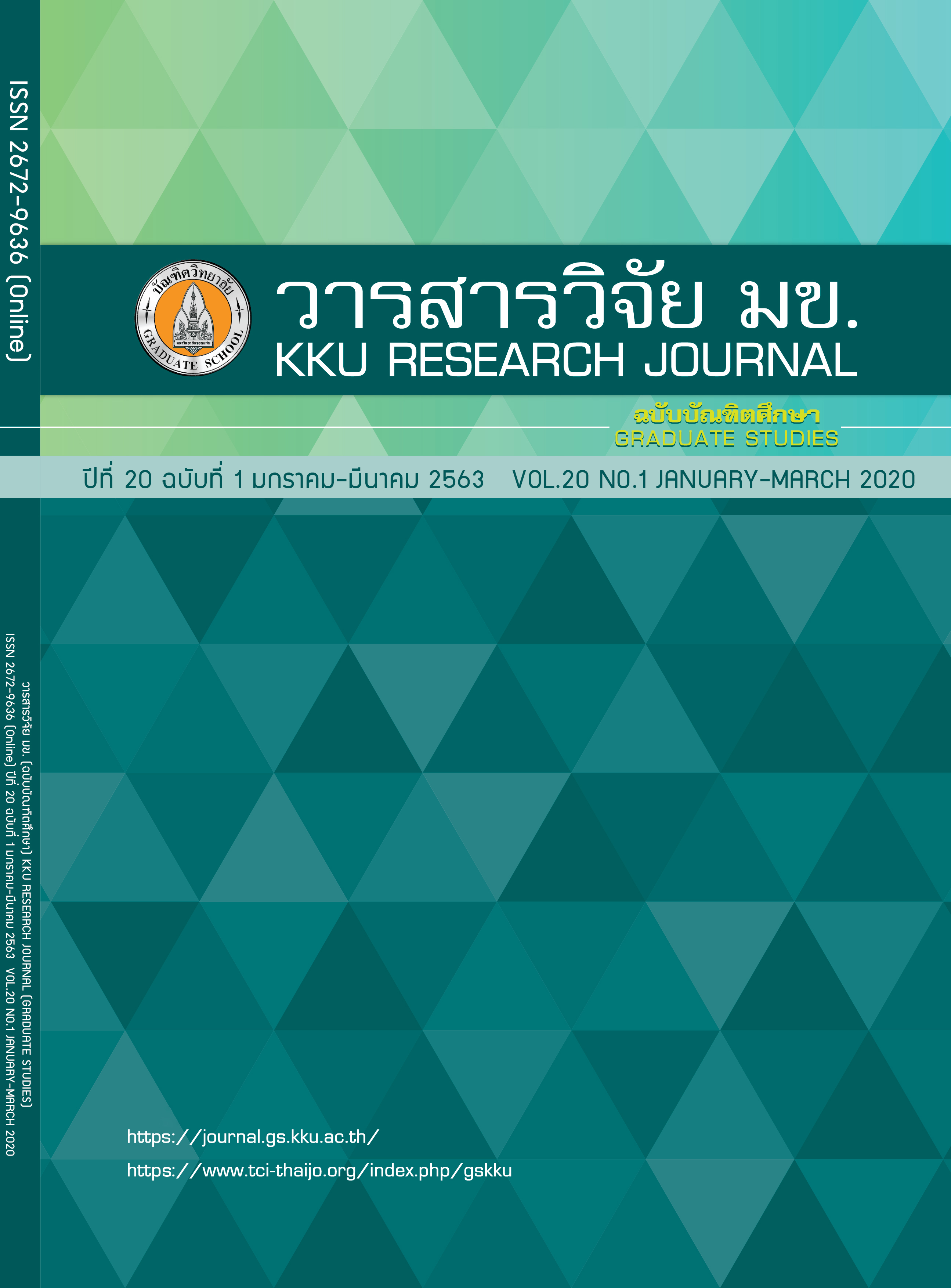แบบจำลองตัวแปรแฝงการรับรู้ต่อการใช้งานระบบจักรยานสาธารณะในมหาวิทยาลัยขอนแก่น
คำสำคัญ:
ระบบจักรยานสาธารณะ, แบบจำลองตัวแปรแฝง, พื้นที่ที่ไม่มีวัฒนธรรมการเดินทางด้วยจักรยานบทคัดย่อ
ตัวแปรแฝงเป็นหนึ่งในตัวแปรสำคัญที่ช่วยให้เข้าใจพฤติกรรมการเลือกใช้งานจักรยานสาธารณะซึ่งเปิดทดลองใช้ภายในเขตมหาวิทยาลัยขอนแก่นในช่วงปี พ.ศ. 2561 การศึกษานี้มีวัตถุประสงค์เพื่อสร้างตัวแปรแฝงและพัฒนาแบบจำลองตัวแปรแฝงการรับรู้ต่อการใช้งานระบบจักรยานสาธารณะ งานวิจัยใช้แบบสอบถามสำรวจกลุ่มตัวอย่างจากผู้เดินทางในเขตมหาวิทยาลัยขอนแก่นจำนวน 396 คน จัดกลุ่มปัจจัยโดยการวิเคราะห์ปัจจัยเชิงสำรวจ (Exploratory Factor Analysis, EFA) และสร้างแบบจำลองตัวแปรแฝงด้วยแบบจำลองมิมิค (MIMIC Models) ผลการศึกษาพบว่า ตัวชี้วัดค่าระดับการรับรู้ในการใช้งาน 13 ตัวชี้วัดซึ่งสะท้อนถึงการให้ความสำคัญและความพึงพอใจของผู้เดินทาง สร้างตัวแปรแฝง 3 ตัว ได้แก่ 1) คุณลักษณะของจักรยาน 2) การเข้าถึงจักรยาน และ 3) ความปลอดภัย ตัวแปรแฝงที่สร้างขึ้นได้รับอิทธิพลอย่างมีนัยสำคัญจากคุณลักษณะของผู้ใช้ ได้แก่ อายุ เพศ และความถี่ในการใช้จักรยาน ผลการศึกษาช่วยให้เข้าใจความสัมพันธ์ระหว่างคุณลักษณะของผู้เดินทาง ปัจจัยแฝง และค่าระดับการรับรู้ต่อการใช้งาน ซึ่งเป็นข้อมูลที่เป็นประโยชน์ในการวางแผนเพื่อสนับสนุนการใช้จักรยานสาธารณะในพื้นที่ที่ไม่มีวัฒนธรรมในการเดินทางด้วยจักรยาน
เอกสารอ้างอิง
Fernández-Heredia Á, Jara-Díaz S, Monzón A. Modelling bicycle use intention: the role of perceptions. Transportation (Amst). 2016;43(1):1–23.
Ben-Akiva M, Walker J, Bernardino AT, Gopinath DA, Morikawa T, Polydoropoulou A. Integration of Choice and Latent Variable Models. In Perpetual Motion. 2007;(1):431–470.
Rietveld P, Daniel V. Determinants of bicycle use: Do municipal policies matter? Transp Res Part A Policy Pract. 2004;38(7):531–550.
Hunt JD, Abraham JE. Influences on bicycle use. Transportation (Amst). 2007;34(4):453–470.
Efthymiou D, Antoniou C, Waddell P. Factors affecting the adoption of vehicle sharing systems by young drivers. Transp Policy [Internet]. 2013;29:64–73. Available from: http://dx.doi.org/10.1016/j.tranpol.2013.04.009. http://dx.doi.org/10.1016/j.tra.2016.04.006.
Kaplan S, Manca F, Nielsen TAS, Prato CG. Intentions to use bike-sharing for holiday cycling: An application of the Theory of Planned Behavior. Tour Manag [Internet]. 2015;47:34–46. Available from: http://dx.doi.org/10.1016/j.tourman.2014.08.017.
Verma M, Rahul TM, Reddy PV, Verma A. The factors influencing bicycling in the Bangalore city. Transp Res Part A Policy Pract [Internet]. 2016;89:29–40. Available from: http://dx.doi.org/10.1016/j.tra.2016.04.006.
Motoaki Y, Daziano RA. A hybrid-choice latent-class model for the analysis of the effects of weather on cycling demand. Transp Res Part A Policy Pract. 2015;75(February):217–30.
Hair JF, Jr. Black WC, Babin BJ, Anderson RE, Tatham RL. Multivariate data analysis. (6thed). New Jersey: Prentice Hall. 2006.



